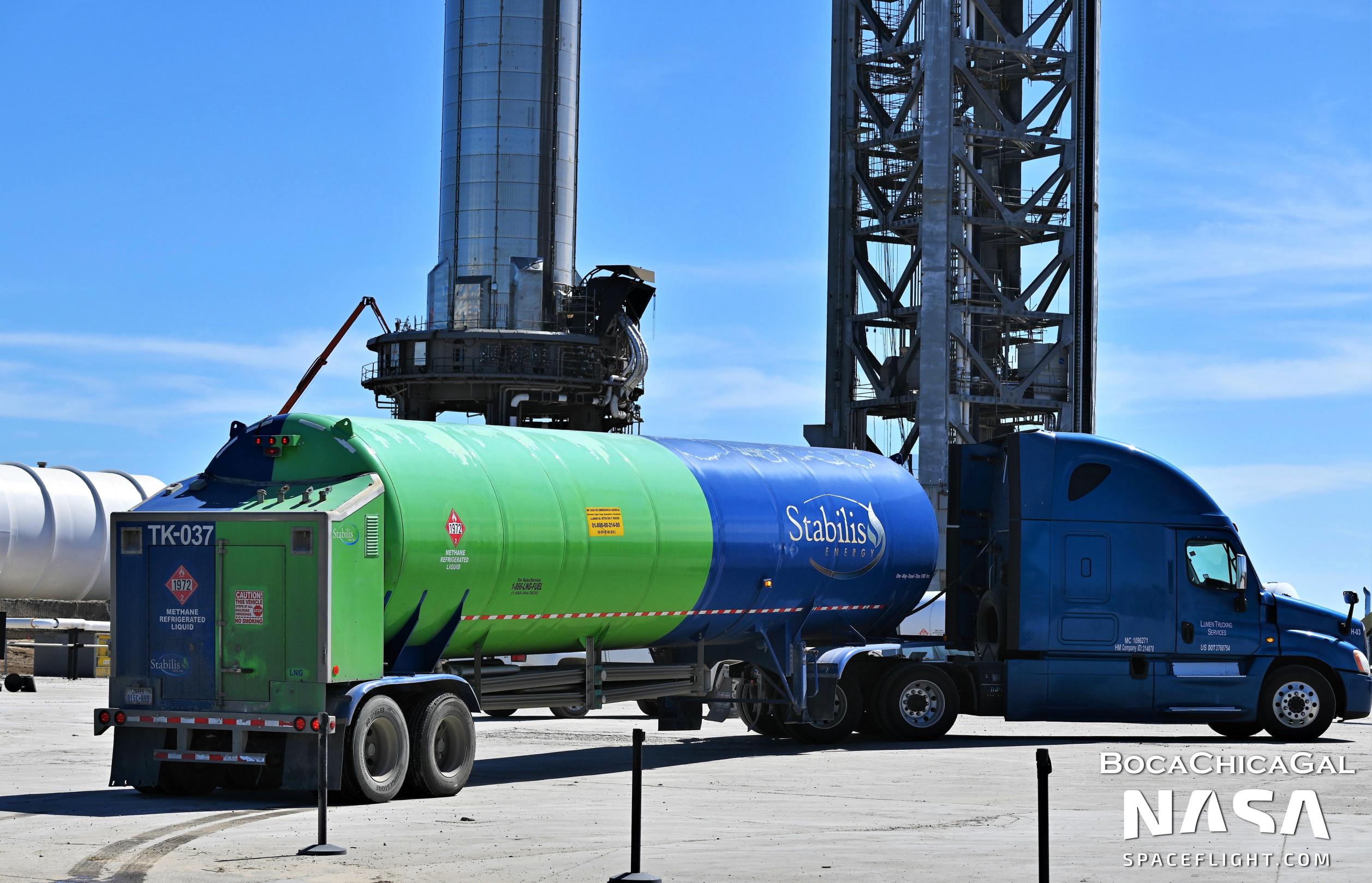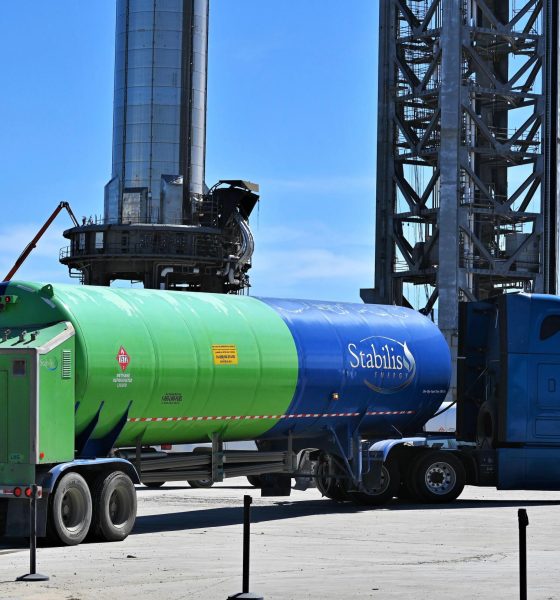

News
SpaceX has finally begun filling Starship’s orbital launch site fuel tanks
Almost five months after SpaceX began the process of filling and testing the first custom-built propellant storage system for Starship, the largest rocket ever built, the company has finally begun to fill the fuel half of the ‘tank farm’.
SpaceX began delivering truckloads of liquid nitrogen (LN2) to the LN2 and liquid oxygen (LOx) sections of the tank farm in mid-September 2021, well before the farm was anywhere close to completion. In about a month, SpaceX accepted ~60 LN2 deliveries – enough to partially fill one of the farm’s seven cryogenic tanks. Instead of some operational purpose, that LN2 was likely used to clean and partially proof the farm’s three LOx tanks. Just two weeks later, the orbital tank farm received its first LOx deliveries.
At the time, mere days after the basic structure of the main tank farm storage system was effectively completed, most figured that it would take SpaceX about as long to clean, proof, and begin filling the farm’s two liquid methane tanks. That would not be the case.
SpaceX installed the second of the farm’s two vertical SpaceX-built cryogenic liquid methane (LCH4) tanks in mid-October 2021. All seven cryogenic tanks had ‘sleeves’ – designed to be filled with foam insulation – installed by the end of the month, effectively completing the farm’s basic structure half a year after assembly began. However, around the same time, SpaceX also installed two horizontal tanks that were also identified as LCH4 storage – giving the overall tank farm far more fuel storage than its oxidizer (LOx) tanks could match. Starship’s Raptor engines burn about 3.55 kilograms of LOx for every 1 kilogram of LCH4.
As work on the vertical LCH4 tanks appeared to slow to a crawl, it took until December 2021 for SpaceX to begin cleaning and proofing the farm’s horizontal LCH4 tanks with liquid nitrogen. By that time, a rough unofficial narrative had been constructed to explain the lack of progress on the farm’s fuel half. Namely, in an excellent Twitter thread, CSI Starbase made a strong case that SpaceX appeared to have designed the first orbital-class Starship tank farm – a compact and pleasingly symmetric set of eight vertical storage tanks – without taking into consideration rudimentary Texas regulations for the storage of liquid natural gas and methane. By all appearances, that conclusion was correct, as the farm was visibly violating several rules – namely the requirements that all LCH4 storage be surrounded by six-foot-tall retaining walls and that all associated plumbing not be situated under power cabling.
As it exists, the LCH4 side of the vertical tank farm violates both of those rules and it’s not obvious that there is actually enough space between the two vertical methane tanks to build a retaining wall with two feet of horizontal clearance. It’s possible that the situation is more complex and that SpaceX intentionally broke those rules or was pursuing an exception to them but the end result was that those vertical LCH4 tanks have yet to be finished, let alone cleaned or proof tested. Instead, SpaceX appears to have fully refocused on horizontal tanks and most recently tore down a dirt berm beside them and began preparing foundations for at least two or three more.
Those horizontal tanks appear to store about 1000 cubic meters (~35,000 ft^3) of LCH4, while the vertical tanks would have stored about 1800 m^3. To fully replace them, SpaceX will need approximately four horizontal tanks – two more in addition to the two already installed. Thankfully, SpaceX has finally begun filling the already installed tanks while it works to expand the methane farm, beginning with three truckloads on the very first day – February 13th, 2022.

To fill the two existing tanks, which may store enough methane to fuel a stacked Starship and Super Heavy about 4/5ths of the way, SpaceX will need around 40-50 more tanker deliveries. Since last November, SpaceX has completed more than 320 liquid nitrogen and 200 liquid oxygen deliveries – equivalent to about 6700 tons (~14.8M lb) of LN2 and 4200 tons (~9.3M lb) of LOx. If SpaceX maintains that average and focuses entirely on LCH4, the two horizontal tanks could be filled to the brim before the end of February.
Having a substantial amount of LCH4 stored at the orbital tank farm will finally allow SpaceX to attempt the first major wet dress rehearsals (WDRs) and, more importantly, the first full static fires with flightworthy Super Heavy booster prototypes. Of course, a tank farm with full supplies of LOx, LCH4, LN2, and their gaseous equivalents is also a necessity for the first orbital Starship launch attempt, which has most recently slipped from a target of mid-2021 to no earlier than (NET) Q2 2022, pending regulatory approval.

News
Tesla starts showing how FSD will change lives in Europe
Local officials tested the system on narrow country roads and were impressed by FSD’s smooth, human-like driving, with some calling the service a game-changer for everyday life in areas that are far from urban centers.

Tesla has launched Europe’s first public shuttle service using Full Self-Driving (Supervised) in the rural Eifelkreis Bitburg-Prüm region of Germany, demonstrating how the technology can restore independence and mobility for people who struggle with limited transport options.
Local officials tested the system on narrow country roads and were impressed by FSD’s smooth, human-like driving, with some calling the service a game-changer for everyday life in areas that are far from urban centers.
Officials see real impact on rural residents
Arzfeld Mayor Johannes Kuhl and District Administrator Andreas Kruppert personally tested the Tesla shuttle service. This allowed them to see just how well FSD navigated winding lanes and rural roads confidently. Kruppert said, “Autonomous driving sounds like science fiction to many, but we simply see here that it works totally well in rural regions too.” Kuhl, for his part, also noted that FSD “feels like a very experienced driver.”
The pilot complements the area’s “Citizen Bus” program, which provides on-demand rides for elderly residents who can no longer drive themselves. Tesla Europe shared a video of a demonstration of the service, highlighting how FSD gives people their freedom back, even in places where public transport is not as prevalent.
What the Ministry for Economic Affairs and Transport says
Rhineland-Palatinate’s Minister Daniela Schmitt supported the project, praising the collaboration that made this “first of its kind in Europe” possible. As per the ministry, the rural rollout for the service shows FSD’s potential beyond major cities, and it delivers tangible benefits like grocery runs, doctor visits, and social connections for isolated residents.
“Reliable and flexible mobility is especially vital in rural areas. With the launch of a shuttle service using self-driving vehicles (FSD supervised) by Tesla in the Eifelkreis Bitburg-Prüm, an innovative pilot project is now getting underway that complements local community bus services. It is the first project of its kind in Europe.
“The result is a real gain for rural mobility: greater accessibility, more flexibility and tangible benefits for everyday life. A strong signal for innovation, cooperation and future-oriented mobility beyond urban centers,” the ministry wrote in a LinkedIn post.
News
Tesla China quietly posts Robotaxi-related job listing
Tesla China is currently seeking a Low Voltage Electrical Engineer to work on circuit board design for the company’s autonomous vehicles.

Tesla has posted a new job listing in Shanghai explicitly tied to its Robotaxi program, fueling speculation that the company is preparing to launch its dedicated autonomous ride-hailing service in China.
As noted in the listing, Tesla China is currently seeking a Low Voltage Electrical Engineer to work on circuit board design for the company’s autonomous vehicles.
Robotaxi-specific role
The listing, which was shared on social media platform X by industry watcher @tslaming, suggested that Tesla China is looking to fill the role urgently. The job listing itself specifically mentions that the person hired for the role will be working on the Low Voltage Hardware team, which would design the circuit boards that would serve as the nervous system of the Robotaxi.
Key tasks for the role, as indicated in the job listing, include collaboration with PCB layout, firmware, mechanical, program management, and validation teams, among other responsibilities. The role is based in Shanghai.
China Robotaxi launch
China represents a massive potential market for robotaxis, with its dense urban centers and supportive policies in select cities. Tesla has limited permission to roll out FSD in the country, though despite this, its vehicles have been hailed as among the best in the market when it comes to autonomous features. So far, at least, it appears that China supports Tesla’s FSD and Robotaxi rollout.
This was hinted at in November, when Tesla brought the Cybercab to the 8th China International Import Expo (CIIE) in Shanghai, marking the first time that the autonomous two-seater was brought to the Asia-Pacific region. The vehicle, despite not having a release date in China, received a significant amount of interest among the event’s attendees.
Elon Musk
Elon Musk and Tesla AI Director share insights after empty driver seat Robotaxi rides
The executives’ unoccupied tests hint at the rapid progress of Tesla’s unsupervised Robotaxi efforts.

Tesla CEO Elon Musk and AI Director Ashok Elluswamy celebrated Christmas Eve by sharing personal experiences with Robotaxi vehicles that had no safety monitor or occupant in the driver’s seat. Musk described the system’s “perfect driving” around Austin, while Elluswamy posted video from the back seat, calling it “an amazing experience.”
The executives’ unoccupied tests hint at the rapid progress of Tesla’s unsupervised Robotaxi efforts.
Elon and Ashok’s firsthand Robotaxi insights
Prior to Musk and the Tesla AI Director’s posts, sightings of unmanned Teslas navigating public roads were widely shared on social media. One such vehicle was spotted in Austin, Texas, which Elon Musk acknowleged by stating that “Testing is underway with no occupants in the car.”
Based on his Christmas Eve post, Musk seemed to have tested an unmanned Tesla himself. “A Tesla with no safety monitor in the car and me sitting in the passenger seat took me all around Austin on Sunday with perfect driving,” Musk wrote in his post.
Elluswamy responded with a 2-minute video showing himself in the rear of an unmanned Tesla. The video featured the vehicle’s empty front seats, as well as its smooth handling through real-world traffic. He captioned his video with the words, “It’s an amazing experience!”
Towards Unsupervised operations
During an xAI Hackathon earlier this month, Elon Musk mentioned that Tesla owed be removing Safety Monitors from its Robotaxis in Austin in just three weeks. “Unsupervised is pretty much solved at this point. So there will be Tesla Robotaxis operating in Austin with no one in them. Not even anyone in the passenger seat in about three weeks,” he said. Musk echoed similar estimates at the 2025 Annual Shareholder Meeting and the Q3 2025 earnings call.
Considering the insights that were posted Musk and Elluswamy, it does appear that Tesla is working hard towards operating its Robotaxis with no safety monitors. This is quite impressive considering that the service was launched just earlier this year.








